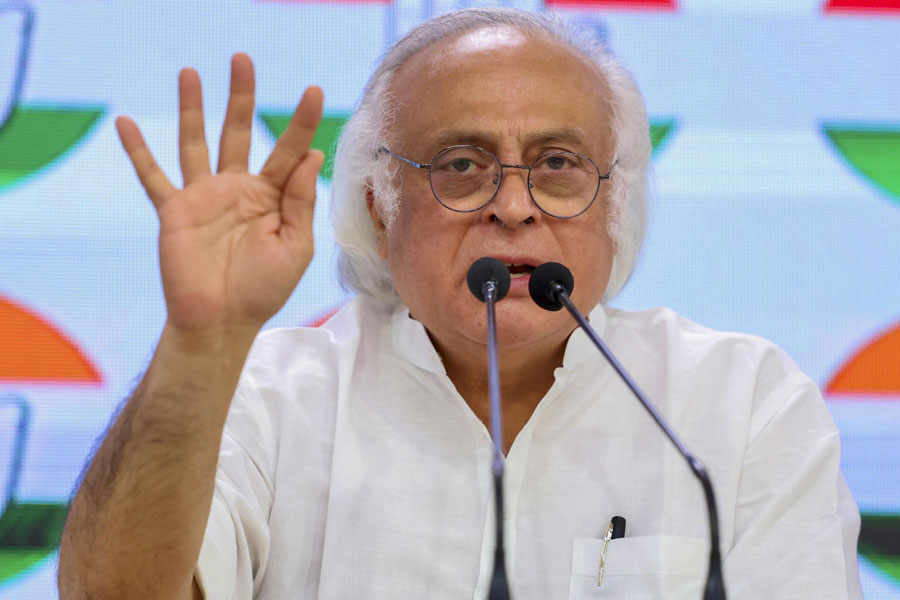My friend and his wife went to see Thakshak the other day. The word was apparently chosen by the director, Govind Nihalani, not so much because of its meaning but its sound. The film represents Nihalani's excursion from middle-of-the-road realist cinema into the territory of popular film. It's interesting that Nihalani should herald this crossing over into the realm of popular art with sound taking precedence over sense; decades ago, Shobha Dé , then Kilachand, sanctified lowbrow film journalism, in the hypnotic argot of her column 'Neeta's Natter', with the feline syllable: 'Meeeow'. Assonances and sounds multiply everywhere in popular culture; even the early dicta describing it are themselves alliterative, assonantal and self-repeating - 'The medium is the message'; 'Celebrities are people who are famous for being famous'.
Thakshak, my friend told me, was enjoyable, as long as you accepted it was a copy of the mafia and gangster films of Hollywood. 'Copying' and theft have, indeed, an honourable lineage in Hindi cinema. Zeenat Aman, strumming the guitar and singing the words, 'Chura liya hai tumne jo dil', may not have been aware that it wasn't only her heart that had been stolen, but the tune as well, from 'If it's Tuesday, it must be Belgium'; if Eliot once declared, 'Mature poets steal; immature poets imitate', or words to that effect, R.D. Burman's 'Chura liya' was no less a manifesto and a proclamation.
The idea of plagiarisation is probably not as fundamental to our culture as it has been in the post-Romantic West; one might imagine the number of lawsuits that might have proliferated among the bhakti poets and Kalighat patuas, for instance, if it had been so. In his Collected Essays, A.K. Ramanujan meditates on the fact that a number of stock lines, phrases, images, and sentiments are transferred from poem to poem, like a kind of currency, a form of free trade, in classical Tamil poetry, without, in their poets' eyes, compromising the individuality of each poem; here, the original and the borrowed are not in opposition to each other.
The Hindi gangster films - what little I have seen of them on television; Satya, excerpts from Arjun, others I don't know the names of - are a form of translation. One set of codes - in this case, to do with the underworld of Chicago or New York - is transferred onto another - the representation of the Mumbai underworld. We have heard of the term 'pale imitation'; yet perhaps 'pale original' would be more in order here. For Hollywood has become increasingly inward-looking, its films arrested by their formulae; increasingly, they are distinguished only by their preoccupation with special effects and 'aliens'.
Even relatively successful gangster films like The Untouchables, which is really a period piece, a noir film dressed up by Merchant-Ivory, pursue, with a few exceptions, the old 'feel-good' Hollywood verities of heroes and villains. Those very formulae, transplanted onto recent Hindi cinema, have served as a kind of release, an opening up of these films to contemporary India. Translation, here, is a way of looking at a changed, hybrid reality. These new films about psychotics or underworld dons let in the contemporary, ambiguous, banal, globalized world - of, for instance, cellphones and one-day cricket matches - into their composition in a way that neither films like The Silence of the Lambs nor more respectable genres such as the novel do.
But another group of practitioners in the arts, besides the filmmakers of Bombay, has studied America closely, and borrowed from its language and forms for its own purposes. I am thinking of the Indian poets who wrote in English in the Sixties, Seventies, and Eighties. Two of the most notable among them, Arvind Krishna Mehrotra and A.K. Ramanujan, have used a diction that bears the self-evident impress of American poetry: Ramanujan, in his unsettlingly quirky line-endings and his misleadingly chatty, confiding tone, takes something from Marianne Moore, and Mehrotra has himself pointed out the importance of Gregory Corso, Felinghetti, Ginsberg, and Hart Crane to his work.
There is only one poet, though, who, like the Mumbai filmmakers, seemed to have realized the potential that the language of the Hollywood gangster films has, and probably used it creatively some time before they did; I am thinking of Arun Kolatkar. Thus, while Kolatkar has a predecessor in William Carlos Williams, he also has a possible ally in Martin Scorcese. More than once, Kolatkar has used the slang spoken in the streets of New York and Chicago to map the psychological terrain of Seventies Mumbai.
Surely the most striking example of the language and structure of the Hollywood mafia film transplanted onto an Indian work of art is not some Bollywood film but the poem 'Ajamil and the Tigers', which occurs in Kolatkar's great sequence of poems, Jejuri (1976). This sequence narrates the arrival of a middle class, ironic, but observant loiterer at an inconsequential pilgrimage town, Jejuri, in Maharashtra. Though the place abounds in myths, it has no important shrines or monuments; the priests and guides themselves don't seem to know the stories they tell too well; yet the narrator, who is not obviously religious, occasionally traverses the distance between irony and wonder.
One of the poems, 'Ajamil and the Tigers', is a retelling of a mystical tale that the narrator may possibly have heard in Jejuri. It is about a pure-hearted shepherd, Ajamil, whose sheep are always threatened by the marauding tigers in the area; the tigers have no success in purloining the sheep mainly because of Ajamil's fearless sheep dog, who vanquishes them again and again. The tale is narrated in the idiom of the Hollywood gangster movie. Ajamil and his sheep dog play the unassailable policeman and his deputy; the leader of the tigers a kind of mafia don who, at one point, promises: 'I'm gonna teach that sheep dog a lesson he'll never forget'. 'Nice dog you got there', the 'tiger king' tells Ajamil at last, after a battle, 'spitting out a tooth'. And he complains to Ajamil that his tigers are starving to death, thanks to the intrepid sheep dog.
In its mixture of mysticism and machismo, the poem looks forward to the globalized, Hindu revivalist Mumbai of the Nineties, where religion and terror went hand in hand. But a benign humour prevails in Kolatkar's poem. The solution Ajamil proposes to the tiger king is both ecologically sound and a parodic inversion of the culture of mafia protectionism; he gifts the tigers a few of his sheep in return for the rest being left in peace. For, as the narrator points out, 'Like all good shepherds he knew/ that even tigers have got to eat some time'.
This conclusion, both reminiscent and parodic of Blake, who spoke of the tiger in proximity to the lamb, is also a subtle comment on the act of creation as translation, from which the poem itself springs; instructing us, as it does, that it's impossible for something to originate without it being involved in a transaction with other points of view, other selves, other languages.
 Wednesday, 25 June 2025
Wednesday, 25 June 2025









